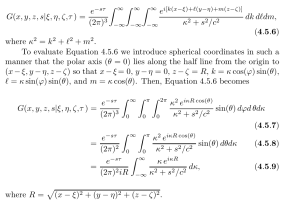Hello everyone,
I am studying a book about derivation of Green's function for three dimensional wave equation. In a part of this book it is stated as follows:

I don't understand how this transformation is done. What does it mean geometrically that
I am studying a book about derivation of Green's function for three dimensional wave equation. In a part of this book it is stated as follows:

I don't understand how this transformation is done. What does it mean geometrically that
and how [imath]x-\zeta=0[/imath], [imath]y-\eta=0[/imath] and [imath]z-\xi=R[/imath] are obtained?in such a manner that the polar axis ([imath]\theta=0[/imath]) lies along the half line from the origin to ([imath]x-\zeta[/imath], [imath]y-\eta[/imath], [imath]z-\xi[/imath])
Last edited:
